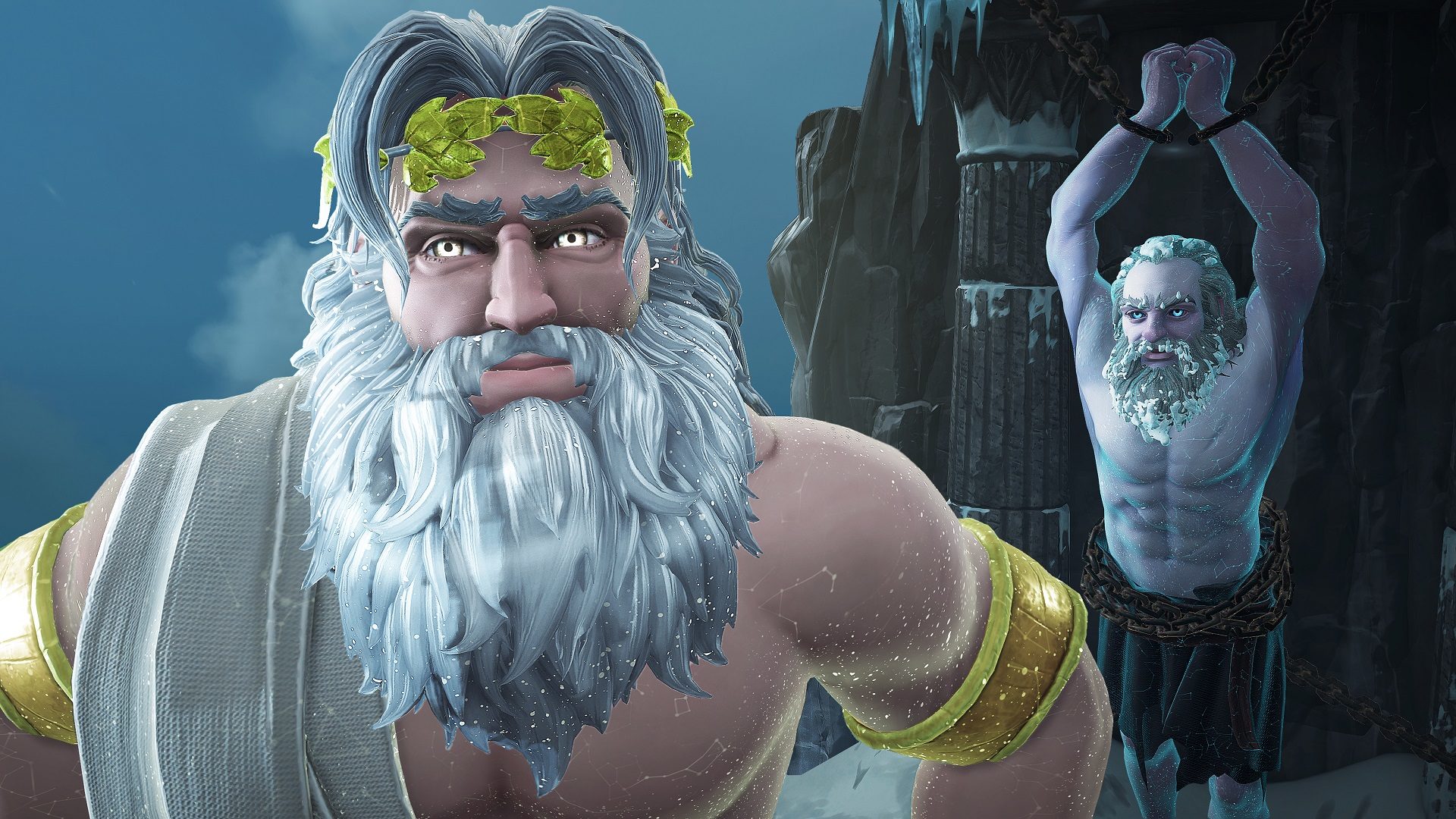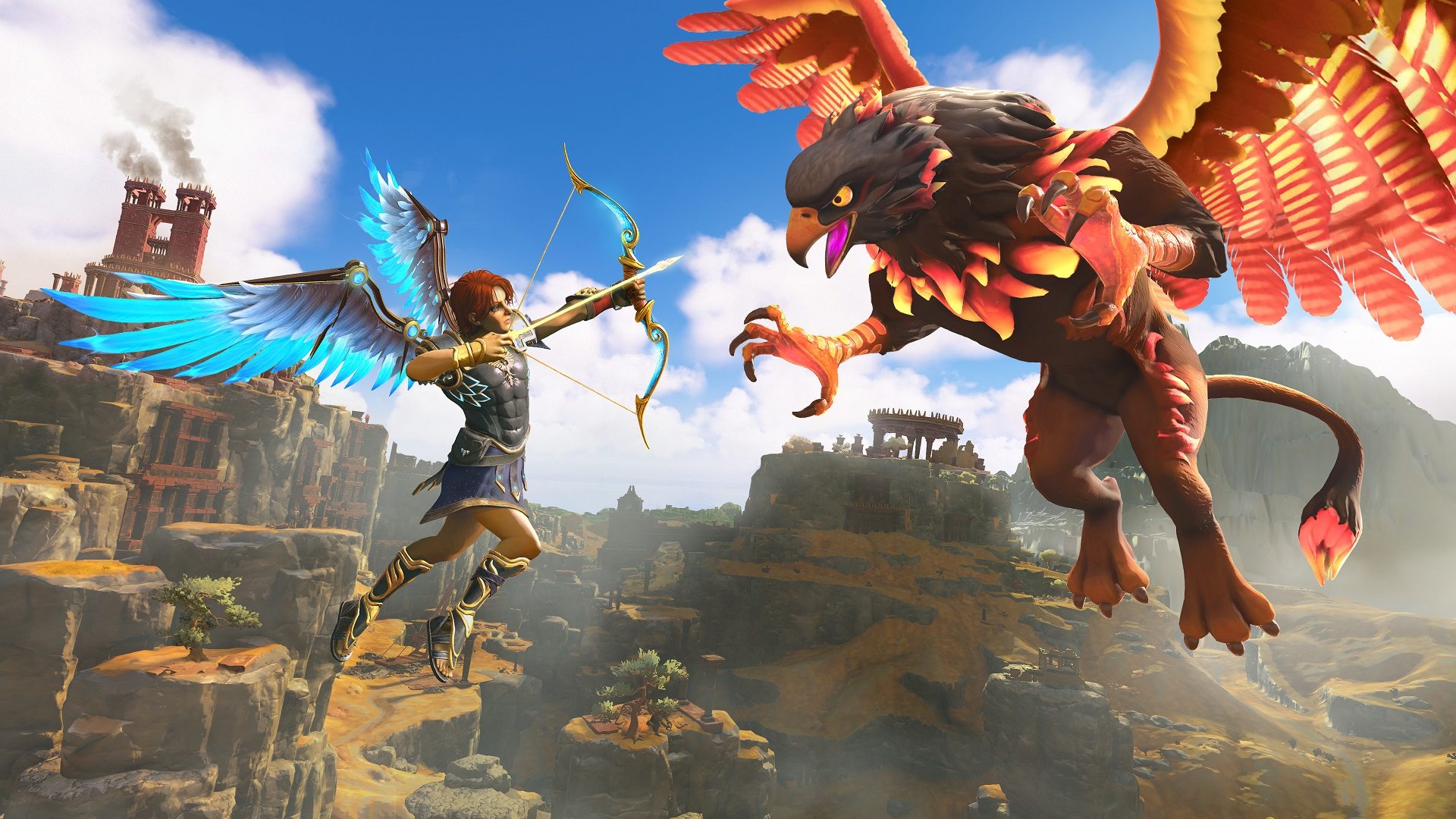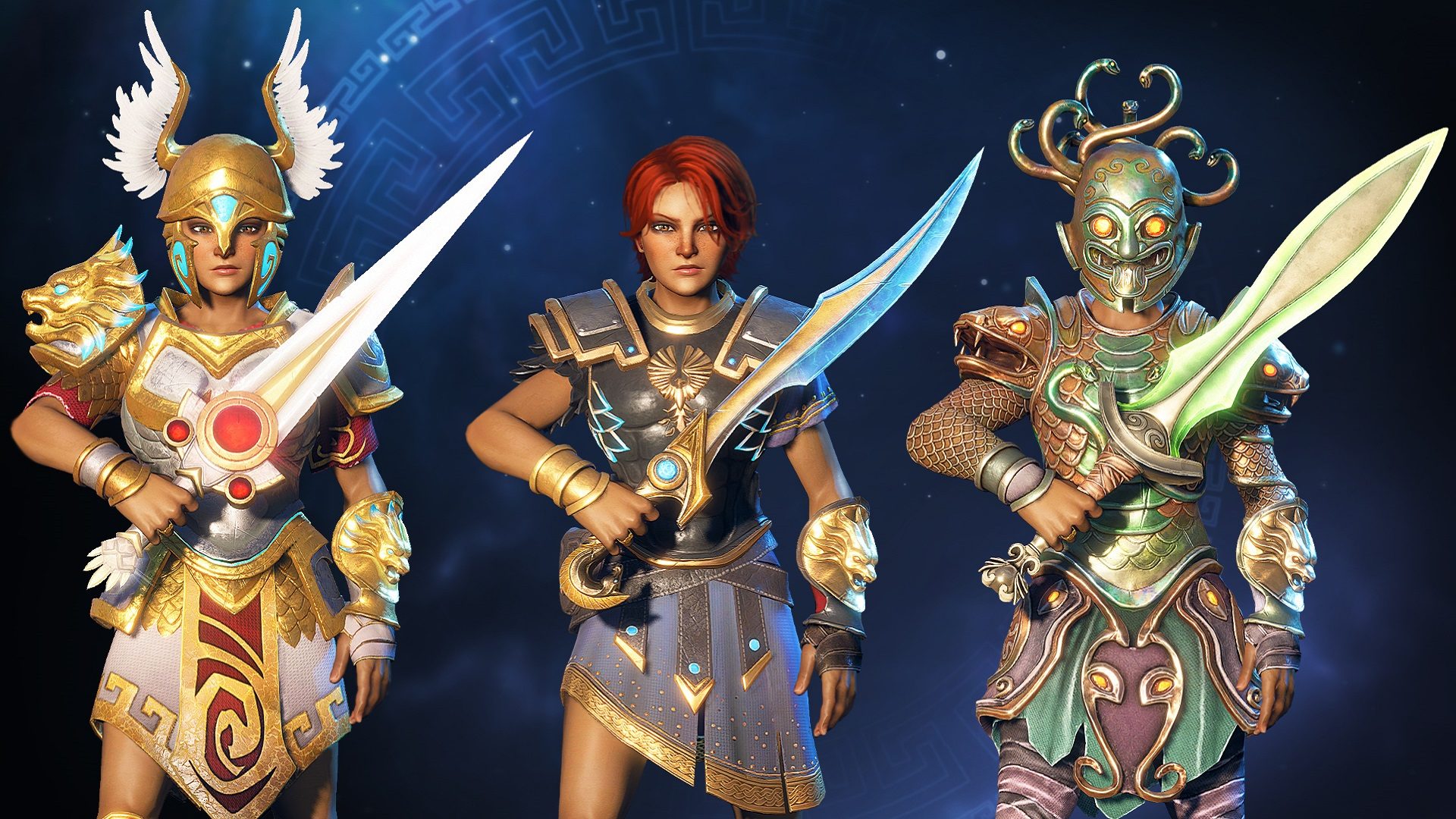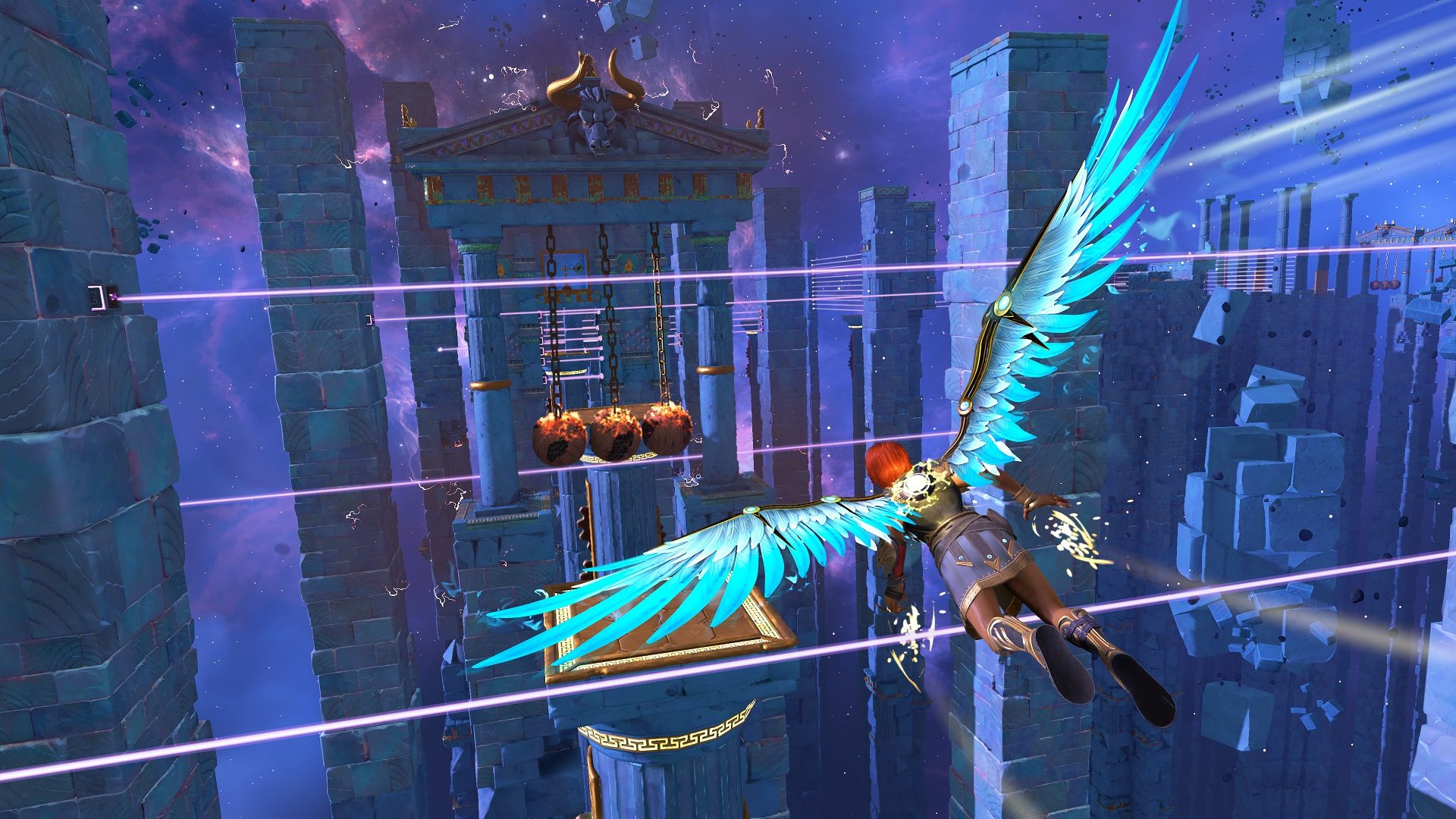I have to imagine that Immortals Fenyx Rising—previously known by, in the opinion of this old-timey gamer, the far better title of Gods & Monsters—made for the easiest elevator pitch of all time.
“What if Assassin’s Creed Odyssey, but also Breath of the Wild?”
I’m not saying that flippantly. I understand how lazy it can be to describe something as “X meets X.” Trust me. I live in Los Angeles. I’ve heard that pitch a million times. But based on the two hours I spent playing Immortals Fenyx Rising, “Assassin’s Creed Odyssey meets Breath of the Wild” is exactly what the game is, right down to the shrines.
Backing up for a moment, Immortals Fenyx Rising is an open-world, action-adventure game set on a mythical island where the Olympians all live (I’m guessing the more traditional mountain wouldn’t have been the easiest setting for designing an open-world game). Unfortunately for them, a vengeful Titan named Typhon declares war on the Olympians and manages to take control of the island. But the prophecy states that a mortal hero named Fenyx—who you can customize, though we didn’t get to go hands-on with that feature—would one day rise to defeat the Titan and make way for the Olympians once more.
Immortals is definitely playing a little fast and loose with Greek mythology. It’s hard to imagine that Odyssey’s sci-fi vision of the Greek gods would have hewed closer to the source material than the more straightforward Immortals, but developer Ubisoft Quebec (which also made Odyssey) is obviously going for a more lighthearted take in this one. One look at the Breath of the Wild–style art direction and the adorable gorgons is evidence of that, and Zeus and Prometheus’ humorous co-narration provides a cheeky storybook backdrop.

The section of the game that I got to play took place on Hephaestus’ section of the island, and it was appropriately themed around metallurgy. Forges and iron giants fill out the spaces between the more recognizably Greek motifs of columns, cyclopes, and marble statues. My first objective when stepping into Fenyx’s laced sandals was to clear out enemies who were hanging around a Vault, which doubly served as a tutorial for the game’s combat in a moment that was specific to the demo I played.
Anyone who’s played Assassin’s Creed Odyssey should feel instantly at home with Immortals’ control scheme, because it’s exactly the same. When it comes to combat, you’ve got a light attack, a heavy attack, a ranged weapon, a parry, a dodge, and a variety of special abilities, all executed with the same buttons and button combinations as they were in Ubisoft Quebec’s last game. Utilizing Fenyx’s specials, for instance, requires holding down the left bumper and pressing the corresponding face button, which seems convoluted on paper but actually becomes natural and fluid in no time. Having spent over 100 hours with Odyssey, I instantly took the fight to Immortals’ enemies.
That’s not to say that Immortals isn’t doing anything new with its combat system. On the contrary, Fenyx is more agile and fluid than Kassandra or Alexios, which leads to combat that feels more arcade-y and combo-driven and a little more forgiving while still retaining that technical, counter-focused fighting that made Odyssey’s main characters feel like seasoned warriors.
The difference is partly in the numbers, I think. While Kassandra and Alexios excelled when facing off against a single enemy, or at least a thinned herd of enemies, Immortals was almost boring when I wasn’t being completely overwhelmed by mythological enemies.
In her abilities, Fenyx has so many crowd-control tools that can quickly transfer into a long combo. The Spears of Ares launches most enemies in a small area around Fenyx high into the air, which can then be followed up with quick aerial attacks that will juggle the helpless targets. The Shield of Athena, meanwhile, is a dash move that can put some quick damage on an enemy while getting Fenyx out of a jam.

These abilities complement the combat system’s solid foundation. You can combo light and heavy attacks in the way that you’d expect, or whip out Fenyx’s bow and arrow for ranged attacks. Hitting enemies not only damages them but also builds up a secondary stun meter. Similar to Sekiro’s posture meter, filling up an enemy’s stun meter will temporarily incapacitate them, giving you a brief window to do as much damage as possible to them, and connecting with Fenyx’s special abilities are an easy way to build up an enemy’s stun meter.
This might sound like pretty standard stuff, but in practice it’s extremely satisfying to clear out a large group of mythological monsters. Little touches like incoming damage notifiers will make you feel like a complete badass when you last-minute parry a ranged attack coming at you from off screen while in the middle of a fracas.
The way that equipment works is also an improvement over Odyssey, though that’s more due to the nature of the game’s genre. Immortals is more of a straightforward action game, so the gear you pick up won’t have levels attached to it, and there are way fewer pieces, too. Instead, different gear will have different buffs, so you can pick the armor, helmet, and boots that best suit your particular play style without having to worry about upgrading or constantly swapping.

The other half of Immortals Fenyx Rising is its exploration and puzzle-solving, and this is where the game feels a little too derivative for its own good.
While the combat feels like a copy-paste of Odyssey, the rest of the game feels like it’s lifted almost wholesale from Breath of the Wild. Fenyx can climb, glide, ride her horse, and sprint across the map, and all of these mechanics are tied to a recognizable stamina gauge. It’s not that it doesn’t work, because it worked in Breath of the Wild, but it’s that Immortals doesn’t really fix some of that game’s annoying aspects. Yes, climbing can be tense when that stamina gauge ticks down, but why does ascending a mountain still have to be so slow? Couldn’t Fenyx climb faster while the stamina gauge empties more quickly?
Immortals also seems to miss the point when it comes to exploration. What made Breath of the Wild so satisfying was that there was an almost complete lack of icons on the map to guide you. Other than the locations of the Divine Beasts, in order to unlock icons for certain locations, you had to find them first through context clues or just keeping your eyes peeled. Unfortunately, Ubisoft’s often-maligned tendency to fill its map with symbols has found its way into Immortals, and it kind of just ruins the sense of adventure that Breath of the Wild was so adept at creating.
Immortals’ version of Breath of the Wild’s shrines, Zeus’ Vaults, fare a little bit better by comparison. Like the Shrines, completing Vaults gives you the material you need to upgrade your character, in this case Zeus’ Lightning. The main difference is that the Vaults themselves feel like longer obstacle courses that combine alternating moments of combat and puzzle-solving, instead of the Shrines’ more singular focus. I appreciate why the Vaults are in the game, and they’re generally inoffensive and occasionally fun, but they also feel like somewhat weak copies of the original.

There are more focused puzzles and combat situations to be found that aren’t tied to the Vaults, but these generally end up requiring simple actions like weaving a remote-controlled arrow through a series of hoops or solving (gulp) slide puzzles. Developers, stop putting slide puzzles into games. Just stop it.
Immortals so transparently apes certain elements from Breath of the Wild that it would be irresponsible not to make these comparisons, and that’s not necessarily a bad thing. The problem arises when you don’t do anything new with them. Even worse is when Ubisoft’s traditional icon-heavy navigation system actively works against what made those elements so special in the first place. Ubisoft’s use of icons is almost starting to feel like a weird obsession driven by market testing and sales figures, and if I really wanted to be dramatic about it, I’d say pinning them all over an exploration system that’s clearly taken from Breath of the Wild is borderline disrespectful.
Immortals Fenyx Rising does have a lot of potential. Combat is fast, fun, and offers just the right amount of challenge. The world is full of personality and color. The streamlined armor system takes away much of the busywork that was in Ubisoft Quebec’s last game. When I was mixing it up with Minotaurs and solving puzzles, I was having a genuinely good time. But I was also left with the feeling that I was just completing a checklist like I am with so many open-world games.
Maybe this seemed more pronounced since I couldn’t get Breath of the Wild out of my head, and maybe that’s unfair. But after I finished my demo, I pretty much felt like I got it. How much was there to discover, really, when I feel like I’ve already played this game twice before? And with two massive, checklist-driven Ubisoft games coming out in October and November, do we really need another one so soon after?
Immortals Fenyx Rising launches for Xbox Series, PlayStation 5, Xbox One, PlayStation 4, Nintendo Switch, PC, and Stadia on December 3rd.
All images: Ubisoft

Michael Goroff has written and edited for EGM since 2017. You can follow him on Twitter @gogogoroff.